BlueChew Before and After Pictures
What is BlueChew? This guide will show and tell you everything you need to know about how BlueChew ED medication works.
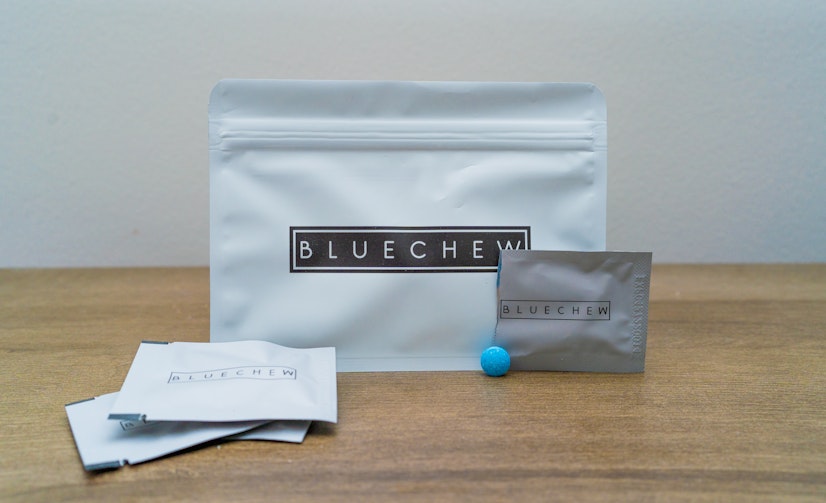
Photo by Innerbody Research
Erectile dysfunction (ED) is a very common sexual condition that affects men of all ages due to a variety of potential underlying factors. One study from 2013 concluded that ED affects over one-quarter of all men under 40.1 The condition becomes more common as men age.
The good news is that modern pharmaceutical research in recent decades has delivered treatments that prove quite effective at treating ED for many men. And more recently, telemedicine has advanced to the point where you can access these prescription treatments with just an internet connection and then get them delivered directly to your front door.
BlueChew ED medication is one of the most well-known options of this kind to treat erectile dysfunction, and its treatments are effective for many men. But how does it work, and what does successful treatment look like? One of the most common searches people perform on our website is for "BlueChew before and after pictures." On this page, we’ll show how BlueChew works using the latest 3D imaging technology.
Jump to:
What is an erection?
Contrary to popular beliefs that men can get an erection and have an orgasm at the drop of a hat, in reality, there are several intricate things happening in order to make that erection possible.
- Psychologically, a man must be relaxed enough and in a healthy mindset to be properly aroused. If a man is under intense stress or dealing with depression, for example, ED may result. (Sleep disorders can ultimately cause ED as well.)
- Physically, an erection is the result of signaling from the brain to the nerves in a man’s penis. Erections can only happen if the brain can effectively signal via the parasympathetic nervous system to the cavernous nerve.
- Blood must be able to flow sufficiently into the spongy tissues of the penis and stay there. Underlying conditions like high blood pressure, atherosclerosis, and type 2 diabetes can lead to ED because of insufficient blood flow or long-term damage to nerves and blood vessels. (Thankfully, the prescription medications present in BlueChew have been shown in studies — such as a study from 2018 — and in medical practice to help many men with diabetes achieve erections in spite of ED.)2
There are actually three kinds of erections:3
Physical touching of a man's genitals stimulates a man and causes an erection.
Absent any physical stimulation, a person’s memories and thoughts can cause an erection by themselves.
When men are asleep, they get nocturnal erections.
Important penis anatomy to understand
Since we've already mentioned the cavernous nerve above, it's time to give a brief overview of the penis anatomy that is important for understanding erections.
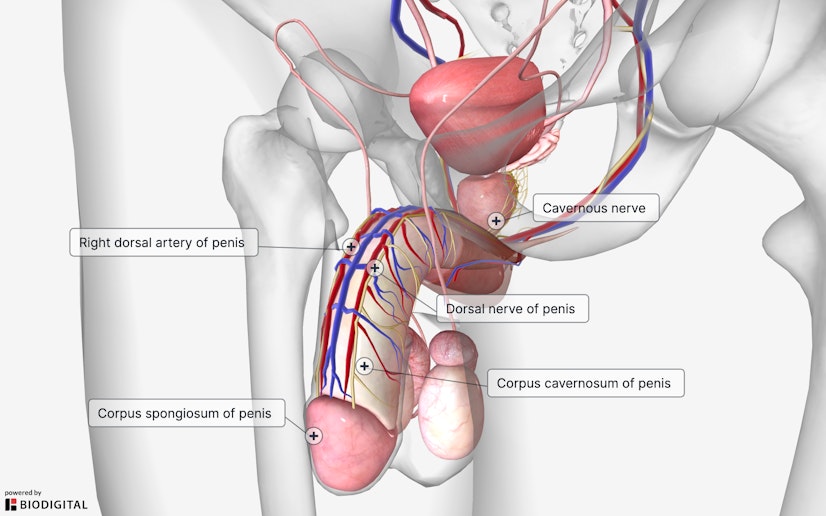
The penis is the largest part of the external male genitalia and is commonly divided into three parts:
- The root
- The body or shaft
- The glans
The root anchors the penis to the pelvic bones while both the body and the glans expand and harden noticeably during an erection. The body (or shaft) of the penis is composed of three columns: the two corpora cavernosa and the corpus spongiosum. These three corpora and associated blood vessels give the penis its erectile, sexual function.
- The corpora cavernosa are made of sponge-like tissue that becomes engorged with blood during an erection.
- The corpus spongiosum surrounds the penile urethra. It also becomes somewhat engorged but to a lesser extent than the corpora cavernosa. This is because the urethra must remain open to provide a viable channel for ejaculation.
The urethra allows urine and semen to exit the body. Meanwhile, the sensation of the penis is provided by the dorsal nerve of the penis, a branch of the pudendal nerve. Important signaling from the brain is received by the cavernous nerve.
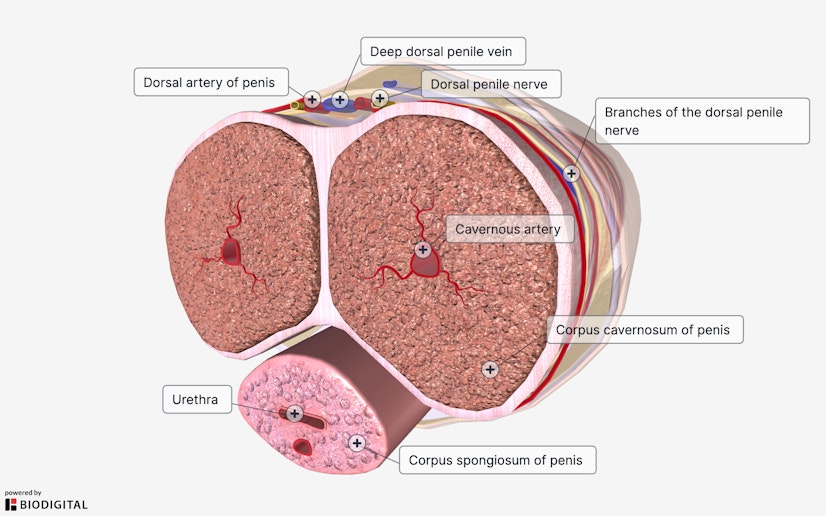
What happens during an erection, step by step
What causes an erection varies depending on the type of erection. But to explore each step in the process of getting an erection, let’s consider the case of a reflexogenic erection.
- A pleasurable sensation in the penis — such as from a touch — is registered by the dorsal nerve of the penis, which sends information to the brain.
- Activating the parasympathetic nervous system, the brain sends a signal to the cavernous nerve, which triggers the release of nitric oxide (NO) from endothelial cells in the penis.
- There's a reason why many fitness buffs associate nitric oxide with improved blood flow during workouts. That's because, vascularly downstream, NO prompts the production of a molecule called cyclic guanosine monophosphate (cGMP), which causes blood vessels to dilate (widen in diameter). In this case, the NO released from cells in the penis causes cGMP to increase within the penis. This cGMP relaxes the smooth muscles in the blood vessels of the penis — yes, there are muscles inside of the blood vessels — and this relaxation causes the vessels to dilate. (This is called vasodilation.)
- Consequently, the dorsal artery of the penis and the deep cavernous arteries dilate, leading to about 20-40 times the normal amount of blood flow and filling the corpora cavernosa with blood.4
- At the same time, the swelling of these tissues compresses veins and significantly reduces the outflow of blood through veins from the penis — particularly the emissary veins but also partly the deep dorsal and circumflex veins that the emissary veins drain into.3 (This is called venous occlusion.) The combination of vasodilation of arteries and venous occlusion means that an unusual amount of blood is now collecting within the penis. The corpora cavernosa continue to engorge, and the penis becomes fully erect, with assistance from the corpus spongiosum.
- So, why don't guys get permanent erections? This is where phosphodiesterase type 5 (PDE5) enters the picture. PDE5 is an enzyme that the body releases to bind to cGMP and metabolize it. PDE5 reduces how much cGMP is free to relax the smooth muscles of the blood vessels supplying blood to the penis. In other words, with enough PDE5 to metabolize cGMP, the blood vessels don't remain dilated, so blood flow reduces and returns to normal. As swelling subsequently reduces, this permits blood to depart the penis via veins that are no longer constricted. And thus, the erection subsides.
That's what happens during a normal erection. But what happens during untreated ED?
Pictures of a penis before using BlueChew to treat ED
Erectile dysfunction is the inability to get and/or maintain a penile erection that is firm and/or enduring enough for sex. Below is an interactive, 3D animated picture showing the penis of a man before pursuing ED treatment such as BlueChew. You can interact with the picture by zooming in or out, rotating it, or clicking specific anatomical objects to gain deeper information.
As you see in the image above, the penis is unable to become fully erect. There are many possible underlying causes for ED. It can occur due to physical or psychological causes that affect any of the areas of the brain, reproductive hormones, emotions, nerves, muscles, and/or blood vessels that are involved with the phenomenon of erection.
However, some underlying causes are more common than others. The most common physical causes of ED include heart disease, atherosclerosis (clogged blood vessels), high blood pressure, nerve damage, type 2 diabetes, and stroke, among others. The most common psychological causes include stress, anxiety, depression, or communication issues with the sexual partner. (Complicating matters, ED itself can cause stress, anxiety, depression, and communication issues.)
Some men with ED are able to get a full erection, but it doesn't last long enough to engage in sexual activity. Other men aren't able to get fully erect — as the 3D picture below depicts — or don't see any physically noticeable changes in their penis.
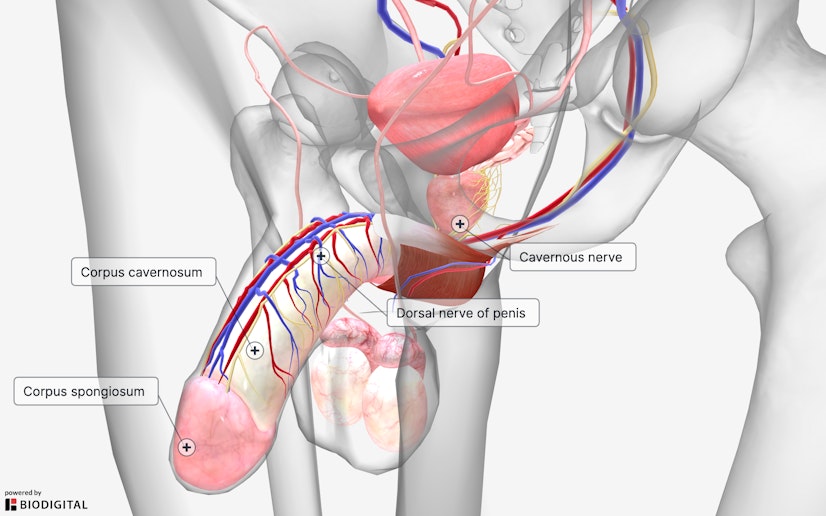
A doctor is able to determine whether ED medication, such as the ones offered by BlueChew, would be a good first course of action. And if so, the doctor can also help you determine which specific medication — sildenafil, tadalafil, vardenafil, or avanafil — is the best starting point for you.
Pictures of a penis after using BlueChew
In contrast to the pictures above, this section provides 3D pictures showing what happens when a person with ED gets an erection after taking BlueChew. Below is an animated 3D depiction of a healthy erection after BlueChew treatment.
And here is an interactive, 3D animated cross-section showing the increased blood flow that can produce a healthy erection after treatment.
The ED medications available from BlueChew can be very effective in treating erectile dysfunction caused by common physiological factors like insufficient blood flow.5 No available medications actually cure ED because they do not address underlying health issues that cause it. Instead, they provide treatment by allowing men to achieve erections.
For those who prefer static pictures to interactive animations, below you can see a labeled picture showing what happens when ED medication from BlueChew enables the normal increase in blood flow that occurs inside the penis after the brain signals to the cavernous nerve that an erection should occur. In contrast to the cross-section image of the non-erect penis much earlier in this article, here you can see how the spongy corpora cavernosa (and, to a lesser extent, the corpus spongiosum that surrounds the urethra) have engorged with blood to enable an erection.
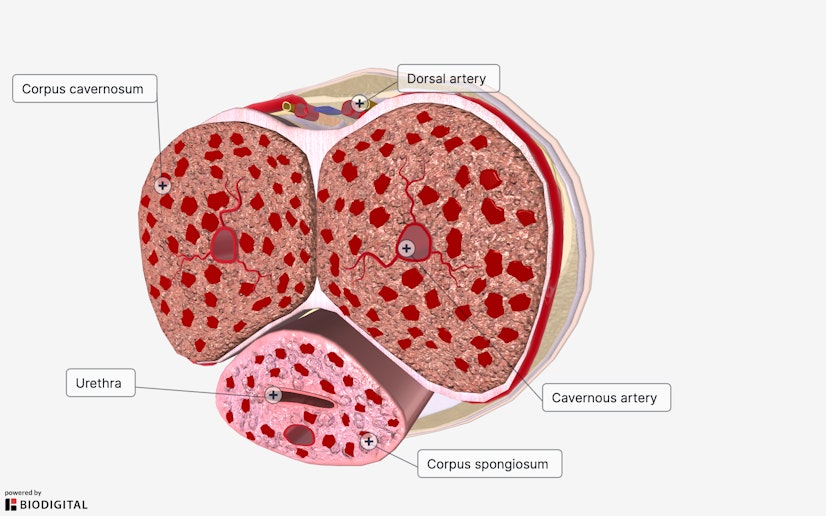
The influx of blood to the penis also causes constriction of veins that would have allowed blood to leave the penis. Here is an image showing how that buildup of blood culminates in an erection.

What is BlueChew?
BlueChew is a website that allows you to get a prescription for ED medication and then receive that medication at home, without going to a doctor's office or pharmacy. BlueChew isn't the only online portal for ED medication, of course; competitors include other big names like Hims and Roman. But BlueChew was the first company to offer chewable ED medications to a wide audience, and until recently, it had little or no competition in that arena.
Now that it's clear that chewable medication is highly desired — whether due to the convenience of not needing a glass of water or the common difficulty of swallowing pills — BlueChew's competitors are trying to steal some of the spotlight by offering their own versions of chewable ED medication. BlueChew remains the only company that exclusively offers chewables, with no pill options on its website. BlueChew is also the only reputable company to offer a free month of ED medication (or $25 off a plan of your choice); you can visit from any link on this page to take advantage of that opportunity.
How sign-up works
Based in Illinois and in operation since 2014, BlueChew can provide its services to any adult with a penis in the United States, except for those in North Dakota. Here's how it works:
- To begin the process, you create a free account.
- Then, you'll complete an online consultation questionnaire that includes, among other things, questions about your activity level, current medications, and cardiovascular health. You should answer all of the questions thoroughly and accurately because the end result could be a prescription treatment, and your safety depends on the prescribing medical professional fully understanding your situation.
- You provide payment and shipping details as well as proof of ID. This is all standard information that telemedical portals require.
- The medical professionals affiliated with BlueChew assess your answers and decide if you're a good and safe candidate for one of the company’s ED medications. If they have a question or want more information than what you provided thus far in consultation, they will pose the question to you; you'll receive an SMS notification that a question exists, and you can log in on BlueChew's website, where you're prompted in a straightforward way to address the question.
- If you are approved for treatment, then BlueChew's ED medication will be shipped directly to your home in nondescript packaging that preserves your privacy. (It doesn't present any revealing brand information.)
How BlueChew ED medications work
Chewable treatments from BlueChew contain sildenafil, tadalafil, or vardenafil — the same active ingredients found in prescription Viagra, Cialis, and Levitra, respectively. The company also offers a daily version of tadalafil for those who prefer to take the medication each day rather than taking it as needed. All of these medications are classified as PDE5 inhibitors because they all facilitate vasodilation in the penis in a similar way.
As described earlier, when the brain activates the parasympathetic nervous system via the cavernous nerve in the penis, it triggers the release of nitric oxide (NO), which, in turn, triggers the production of a molecule called cyclic GMP (cGMP). That molecule acts to relax the smooth muscles in the blood vessels of the penis, and this relaxation causes them to dilate, leading to much more than the normal amount of blood entering the spongy tissues of the penis and causing an erection. PDE5 is the enzyme that binds to and neutralizes cGMP, subsequently causing blood vessels to return to their normal, pre-dilated state and ending an erection.
A PDE5 inhibitor — the type of ED medication you get in BlueChew — binds with the PDE5 enzyme in your body so that it can't bind with the cGMP. This intervention has proven to be effective for many men with ED to achieve erections that are strong, safe, and long-lasting enough for satisfying sex.
Will BlueChew work this way for everyone?
BlueChew will not work this effectively for everyone — it's not a universal treatment because:
- The underlying causes of ED are sometimes not physiological; if your ED has psychological roots, then this will likely not be your solution.
- When physiological causes are at work, sometimes underlying health conditions make the use of PDE5 treatments unsafe or inadvisable.
For many men with ED, though, the medications in BlueChew are safe and effective ways to get an erection.
For our entire review of BlueChew and to learn how you can try a free month of treatment using an exclusive discount code for our readers, check out our comprehensive BlueChew Review.
FAQ about BlueChew
Sources
Innerbody uses only high-quality sources, including peer-reviewed studies, to support the facts within our articles. Read our editorial process to learn more about how we fact-check and keep our content accurate, reliable, and trustworthy.
Capogrosso, P., Colicchia, M., Ventimiglia, E., Castagna, G., Clementi, M.C., Suardi, N., Castiglione, F., Briganti, A., Cantiello, F., Damiano, R., Montorsi, F., Salonia, A. (2013, July 1). One Patient Out of Four with Newly Diagnosed Erectile Dysfunction Is a Young Man—Worrisome Picture from the Everyday Clinical Practice. The Journal of Sexual Medicine. 10(7), 1833-1841.
Li, X., Zhao, Q., Wang, J., Wang, J., Dai, H., Li, H., & Wang, B. (2018). Efficacy and safety of PDE5 inhibitors in the treatment of diabetes mellitus erectile dysfunction: Protocol for a systematic review. Medicine, 97(40).
Dean, R. C., & Lue, T. F. (2005). Physiology of Penile Erection and Pathophysiology of Erectile Dysfunction. The Urologic clinics of North America, 32(4), 379.
Panchatsharam, P.K., Durland, J., Zito, P.M. (2023, May 1). Physiology, Erection. In: StatPearls [Internet]. Treasure Island (FL): StatPearls Publishing; 2023 Jan-.
Gong, B., Ma, M., Xie, W., Yang, X., Huang, Y., Sun, T., Luo, Y., & Huang, J. (2016). Direct comparison of tadalafil with sildenafil for the treatment of erectile dysfunction: a systematic review and meta-analysis. International Urology and Nephrology, 49(10), 1731-1740.











